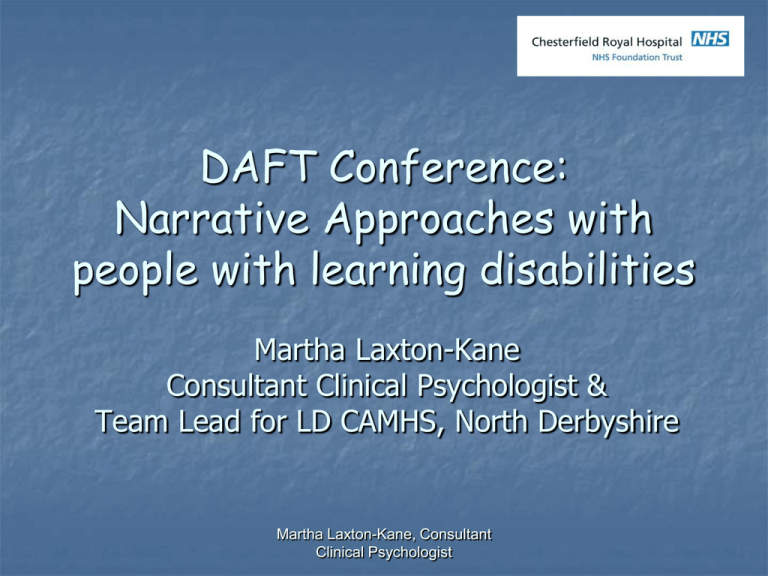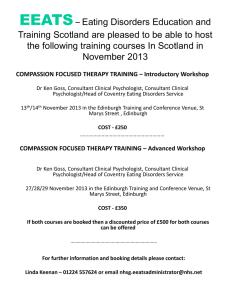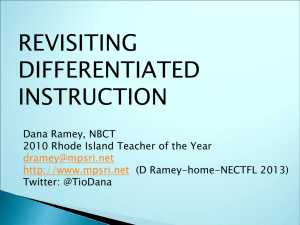Narrative Approaches- Martha - The Derbyshire Branch of AFT
advertisement

DAFT Conference: Narrative Approaches with people with learning disabilities Martha Laxton-Kane Consultant Clinical Psychologist & Team Lead for LD CAMHS, North Derbyshire Martha Laxton-Kane, Consultant Clinical Psychologist Aims 1. 2. 3. Briefly outline the main principles of Narrative Therapy. Consider how Narrative Therapy can be used with people with learning disabilities and their families. Share some examples of practice. Martha Laxton-Kane, Consultant Clinical Psychologist Narrative Therapy: Brief Overview Many ideas originated in Southern Hemisphere with work from David Epston and Michael White Earlier work with children, more recent developments with many other groups of people with variety of ways of working eg community work with indigenous populations From Commonly Asked Questions about NT, www.dulwichcentre.com.au Martha Laxton-Kane, Consultant Clinical Psychologist Stories in our lives Stories – events, linked in sequence, across time, according to a plot. Life is multistoried Martha Laxton-Kane, Consultant Clinical Psychologist Everyone has ‘dominant stories’ (that may be problem saturated) that can be unhelpful to the person. The aim of NT is to help replace the dominant story with an alternative one (to a preferred story), that is currently more thinly described. Dominant stories need to be ‘deconstructed’ and then alternative or preferred ones ‘reconstructed’. Dominant stories – never produced in isolation from the broader world, affect what events are attended to Martha Laxton-Kane, Consultant Clinical Psychologist Some more narrative concepts (adapted from Morgan, 2000) Thin descriptions – often heard early in meetings, often created by others, leave little room for movement Alternative stories – identified by the person as stories by which they would like to live their lives, rich description Unique outcomes Martha Laxton-Kane, Consultant Clinical Psychologist The process according to Matthews & Matthews (2005) involves: (1) (2) (3) (4) Listening to and understanding the person's story Deconstructing the problem stories Re-storying Sustaining the change. Martha Laxton-Kane, Consultant Clinical Psychologist “Briefly, Narrative Therapy uses a story (narrative) metaphor and proposes the meaning we give to our (daily) experiences is determined by the stories we have about ourselves. Stories about life and ourselves are socially, culturally and historically situated and we all have many stories about our lives and relationships: life is multi-storied. The stronger (more dominant) a story’s presence in a person’s life the more their life will be influenced by it. When people come for therapy they are usually in the grip of a (dominant) problem story about their lives. Narrative Therapy engages in externalising conversations moving from the dominant problem story (the known and familiar) to the noticing of alternative and preferred stories of a person’s life (the possible to know). These preferred stories are then systematically ‘thickened’ to enable them to have more influence on a person’s life”. (Hilton 2012) Martha Laxton-Kane, Consultant Clinical Psychologist Externalisation Is just one type of conversation in Narrative, but often provides the base from which other Narrative conversations are built upon. Typical questions: If you could draw x what does it look like? How has x affected your thoughts and feelings? How has x affected your relationship with your boyfriend? Is this effect a good thing or bad thing? Martha Laxton-Kane, Consultant Clinical Psychologist Exercise What might some of the common dominant stories be in the lives of people with learning disabilities? Martha Laxton-Kane, Consultant Clinical Psychologist Martha Laxton-Kane, Consultant Clinical Psychologist Martha Laxton-Kane, Consultant Clinical Psychologist Martha Laxton-Kane, Consultant Clinical Psychologist Videos ……. Martha Laxton-Kane, Consultant Clinical Psychologist General principles of working with people with ld YP with LD often described behaviourally* It will take more time – very repetitive, need smaller steps and realistic aims Need to make abstract concepts more concrete – drawing, writing, play dough, genograms with pictures, concepts into metaphors Do ask others how to respond and observe others interactions… & ask Speech and Language Therapy advice All people with LD will have different levels of ability and understanding. Specialist LD-CAMHS *challenging behaviours can mask physical causes Martha Laxton-Kane, Consultant Clinical Psychologist More general principles of working with people with ld …… Help retention of information with simple letter / summary. Simple agenda and cross off to help YP keep focused / concentrate. Accept going off at a tangent at times / muddled concepts. Martha Laxton-Kane, Consultant Clinical Psychologist Adapting Narrative for people with LD The same principles apply as with the use of other therapies for people with learning disabilities Try and use more concrete concepts (which may be tricky with externalisation) Give people more time to learn and get used to different ways of talking Most of all be creative – use visual imagery to support ideas and act as reminders eg plastercene, drawings, writings, letters, embrace support workers and family etc Martha Laxton-Kane, Consultant Clinical Psychologist Adapting Narrative for people with LD Give the person with LD more time and opportunity Use visual supports to make concepts more concrete It is suggested that for people with more severe LD may have to invite others to give them a voice / adopt their position if they cannot be included. Managing questions / conversations with different family members – clearer who asking questions to and recap frequently. May have to go into the home environment – be Martha Laxton-Kane, Consultant flexible about work Clinical Psychologist What I love about people with learning disabilities A challenge to social rules Small changes are very important A lack of chips and judgements Honoured to be part of families lives Honesty Laughter Learning how other people overcome marginalisation and challenges Martha Laxton-Kane, Consultant Clinical Psychologist Thank-you martha.laxton-kane@nhs.net Martha Laxton-Kane, Consultant Clinical Psychologist Research into Narrative Therapy The relationship between Narrative Therapy and Evidence-based practice Co-research – archives of solution knowledges, asking people what’s helpful, co-research in training and in service evaluation Special edition of International Journal of Narrative Therapy and Community Work (2004, 2) Recent Forum article Use of externalisation with children who soil (Silver et al., 1998) Use of narrative therapy for major depressive disorder (Vromans and Schweitzer, 2010). Also studies looking at use of narrative therapy and eating disorders, and childhood stealing. Martha Laxton-Kane, Consultant Clinical Psychologist References and useful links Matthews, B & Matthews, B (2005) Narrative Therapy: Potential uses for People with Intellectual Disability. International Journal of Disability, Community and Rehabilitation. Hilton, A. (2012) Moving Things to Independent Life: The influence of Narrative Therapy on working with a woman affected by learning disabilities (originally appeared in Clinical Psychology & People with Learning Disabilities, Vol 10, no 2, Sept 2012). Morgan, A. (2000) What is narrative therapy ? An easy-to-read introduction. Adelaide: Dulwich Centre Publications Morgan, A. (2002) Discerning between structuralist and non-structuralist categories of identity : a training exercise. International Journal of Narrative Therapy and Community Work, 4, 52- 55. Silver, E., Williams, A., Worthington, F. & Phillips, N. (1998). Family therapy and soiling: an audit of externalizing and other approaches. Journal of Family Therapy, 20(4), 413-422. Vromans, L. & Schweitzer, R. (2011). Narrative therapy for adults with major depressive disorder: improved symptoms and interpersonal outcomes. Psychotherapy research, 21(1), 4-15. www.dulwichcentre.com.au www.narrativepractice.com Hugh Fox Martha Laxton-Kane, Consultant Clinical Psychologist A Narrative Framework for interviews (adapted from Morgan 2000) PART 1 Naming the problem (externalising conversations) Tracing the history of the problem and the effects of the problem on the person’s life Situating the problem in context – deconstruction (problems survive and thrive when backed up by beliefs and values) Discovering Unique Outcomes (times when the problem has had no or less influence, stories that contradict the dominant problem story) Tracing the history and meaning of the Unique Outcome (naming an alternative story) PART 2 Thickening the alternative story ‘Re-membering’ conversations Therapeutic documentation and letters Witnesses Martha Laxton-Kane, Consultant Clinical Psychologist







